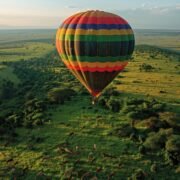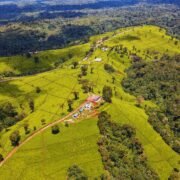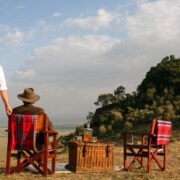
From the Great Migration to the Big 5: When to Visit for the Best Wildlife in Kenya
Why Timing Matters on Safari in Kenya
Kenya is a year-round safari destination, but your wildlife experience can vary greatly depending on when you visit. Whether you’re hoping to witness the thunderous herds of the Great Migration or tick off the legendary Big 5 animals—lion, elephant, rhino, buffalo, and leopard—knowing the best time to go on safari in Kenya is essential for maximizing your adventure.
In this in-depth guide, we break down Kenya’s safari seasons, highlight the best parks for Big 5 sightings, and reveal when to visit for iconic events like the Great Migration in the Maasai Mara. Whether you’re planning a photography safari, a family trip, or a luxury wildlife experience, we’ve got you covered.
Understanding Kenya’s Safari Seasons
Kenya’s climate is shaped by two rainy seasons and two dry seasons. These influence animal movement, visibility, and park accessibility, making some months more favorable for wildlife safaris.
🟢 Green Season (Mid-March to May) – Long Rains
- Rainfall: High
- Pros: Fewer tourists, vibrant green landscapes, excellent birdwatching
- Cons: Muddy roads, some lodges closed, more difficult game viewing
- Safari Verdict: Ideal for budget travelers and birders, but not optimal for Big 5 sightings
🌤️ Dry Season (June to October) – Peak Wildlife Viewing
- Rainfall: Minimal
- Pros: Best time for spotting the Big 5, excellent conditions for the Great Migration
- Cons: Higher prices, more tourists
- Safari Verdict: Best overall time for a safari in Kenya
🌦️ Short Rains (November to Early December)
- Rainfall: Light, brief showers mostly in the evening
- Pros: Fewer crowds, lush scenery, good wildlife viewing continues
- Cons: Some rains may disrupt travel
- Safari Verdict: A shoulder season with good wildlife and reasonable rates
☀️ Hot & Dry Season (December to February)
- Rainfall: Little to none
- Pros: Great time for predator activity and birdlife
- Cons: Can be hot and dusty
- Safari Verdict: Great for photography safaris and Big 5 tracking, especially in parks like Amboseli and Samburu
🐘 When to See the Big 5 in Kenya
The Big 5 can be seen all year round in Kenya’s top national parks and conservancies, but sightings are easiest during the dry seasons (June to October and December to February).
✅ Maasai Mara National Reserve
- Best time: July to October (Great Migration + Big 5)
- Why: Huge densities of lions, elusive leopards, and good chances of spotting rhinos
- Bonus: Home to the Great Wildebeest Migration between July and September
✅ Amboseli National Park
- Best time: January to March, June to October
- Why: Iconic views of elephants with Mount Kilimanjaro in the background, dry terrain makes wildlife easy to spot
- Bonus: Known as the best place to see large elephant herds
Explore our full article on Amboseli’s Luxury Lodges and Elephant Encounters.
✅ Lake Nakuru National Park
- Best time: June to October, December to February
- Why: Excellent for rhino sightings, plus lions and leopards
- Bonus: Flamingos and scenic lake views add a unique touch
✅ Ol Pejeta Conservancy (Laikipia)
- Best time: December to February, June to October
- Why: Best place in East Africa for seeing the last two northern white rhinos
- Bonus: Excellent conservation-focused safaris
Explore our article: Top Luxury Camps in Laikipia.
✅ Tsavo East and West National Parks
- Best time: June to October, January to March
- Why: Largest parks in Kenya, home to red elephants, lions, leopards, and buffalo
- Bonus: Quieter safari experience with fewer tourists
See our full guide: The Ultimate Guide to Tsavo
🦓 The Great Migration in Kenya: When to Go
The Great Wildebeest Migration is one of the most awe-inspiring wildlife events on Earth. Millions of wildebeest, zebra, and gazelle cross the Mara River, facing predators like crocodiles and lions.
📅 Migration Calendar – Maasai Mara, Kenya
- June to July: Herds arrive in Maasai Mara from the Serengeti
- August to September: Best time to witness river crossings (peak safari season)
- October: Herds begin to migrate back to Tanzania
- November to May: Migration occurs in the Serengeti (Tanzania)
👉 For the best chance of seeing the Great Migration, book your 5-Day Classic Big 5 Safari in Maasai Mara and Lake Nakuru between July and September.
📸 Photography Tips by Season
| Season | Best For | Challenges | Tips |
|---|---|---|---|
| June–October | Big 5 + Migration | Busy parks | Book early, pack telephoto lens |
| Nov–Dec | Soft light + newborn wildlife | Some showers | Great for dramatic skies |
| Jan–Feb | Predator activity | Harsh sun midday | Use morning and golden hour |
| March–May | Green backdrops, birds | Muddy, wet | Carry waterproof covers |
For expert photo safaris, check our Luxury Wildlife Photography Tours.
💰 When to Visit for the Best Value
If you’re budget-conscious but still want incredible wildlife experiences:
- Shoulder Seasons: March to early June, or November
- Lodges offer discounts, and the parks are less crowded
- Animals still present, though harder to spot in tall grasses
👉 See our article: Exploring Kenya on a Budget
🛏️ Best Time to Visit Based on Travel Style
| Traveler Type | Ideal Season | Recommended Parks |
|---|---|---|
| First-Timers | July–October | Maasai Mara, Amboseli, Lake Nakuru |
| Luxury Seekers | Jan–Feb, July–Sept | Laikipia, Samburu, Mara conservancies |
| Photographers | Jan–March, July–Sept | Amboseli, Maasai Mara |
| Birdwatchers | March–May | Lake Naivasha, Meru, Rift Valley Lakes |
| Families | Dec holidays, July–Aug | Mara, Amboseli, Naivasha |
| Romantic Travelers | Feb, June, Sept | Mara North, Ol Pejeta, Chyulu Hills |
🗓️ Month-by-Month Safari Calendar
| Month | Highlights |
|---|---|
| January–February | Big cats, elephants, dry weather, baby animals |
| March–May | Green season, fewer crowds, good birding |
| June | Start of peak season, increasing wildlife density |
| July–August | Great Migration, peak safari, dry & clear |
| September–October | Continued migration, predator action |
| November | Short rains begin, great lighting for photos |
| December | Good for families, festive wildlife holidays |
📌 Conclusion: When Should You Go?
The best time to visit Kenya for wildlife depends on your priorities:
- For the Great Migration and Big 5: July to October
- For luxury and photography: January to February
- For budget travel: March to June, or November
- For romance or family holidays: December, or shoulder months
Kenya offers something magical in every season. Whether you’re tracking lions on the Maasai plains, photographing elephants against Kilimanjaro, or marveling at river crossings in the Mara, the wild is always waiting.
🔗 Plan Your Safari Today
Ready to witness Kenya’s wildlife in its raw, breathtaking beauty? Start by exploring our handpicked safari itineraries:
- 🦁 5-Day Big Five Safari – Maasai Mara, Lake Nakuru, Naivasha
- 🐘 Kilimanjaro’s Backdrop: Amboseli Luxury Safari
- 🌍 Laikipia vs Samburu: Which Destination Is Right for You?
Still unsure when to travel? Contact Us and our safari experts will help you choose the perfect time and itinerary for your dream adventure.






